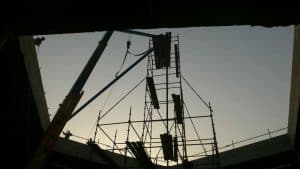NEW BUSINESS EXPANDS FURTHER AT END OF THIRD QUARTER
A renewed increase in housing activity following August’s pause was not enough to prevent a renewed reduction in total output at Irish construction firms amid a fresh fall in commercial activity. More positively, new orders expanded and firms took on extra staff. Companies also remained optimistic around the year-ahead outlook.
The headline seasonally adjusted BNP Paribas Real Estate Ireland Construction Total Activity Index dipped below the 50.0 no-change mark in September, posting 49.0 from a reading of exactly 50.0 in August. Total activity has now decreased in four of the past five months.
Underneath the headline figure, latest data signalled differing trends among the sub-categories of construction than was the case in August. Housing activity returned to growth following a fractional reduction in the previous survey period. Activity on residential projects has now increased in six of the past seven months. In contrast, commercial activity dipped back into contraction during September after having seen growth in August. Civil engineering activity continued to fall.

The slight reduction in total construction activity in September was recorded in spite of a further expansion of new orders during the month. New business increased for the seventh month running, with panellists reporting improving client demand and the sign-off on projects which had been priced in previous months.Construction firms responded to a further expansion of new business by raising staffing levels to help ensure that projects were completed on time. Employment increased modestly, reversing the decline seen in the previous month.
Meanwhile, purchasing activity rose for the seventh month running amid the need for more materials to support construction activity.Those firms that purchased items were faced with longer delivery times from suppliers, the fourth consecutive month in which this has been the case. Delays were linked to a range of factors, including staff shortages at suppliers, difficulties sourcing materials and general supply-chain issues.
Another sharp increase in input costs was recorded in September amid general inflationary pressures on materials and higher wages. That said, the rate of input cost inflation eased for the third successive month and was the slowest since January.
A first rise in sub-contractor usage for three months put pressure on the supply of sub-contractors, with their availability deteriorating to the greatest extent since April.
Construction firms remained optimistic regarding the 12-month outlook for activity, with sentiment broadly in line with the series average despite easing from August. Those companies that predicted a rise in activity over the coming year linked this to confidence regarding new orders and expected increases in housing activity.
Commenting on the latest survey results, John McCartney, Director & Head of Research at BNP Paribas Real Estate Ireland, said:
“September continued along the lines of the last six months with overall activity broadly flat and residential construction out-performing commercial. This pattern reflects conditions in these respective markets. House prices and, to a lesser extent, rents are rising strongly and the demand for residential property is well underpinned by population growth, the strong economy and Government schemes like Help to Buy which was extended again in the recent budget. Notwithstanding a continuous rise in costs since the spring of 2020, these factors have given builders confidence that they can deliver housing profitably, and residential commencements are strongly up. In contrast rising office vacancy has caused new starts in the commercial sector to dry-up, dragging on overall activity.”
_____________________________________________________
Michael McDonnell Managing Editor of Irish Construction Industry Magazine & Plan Magazine
Email: michael@irishconstruction.com WWW.MCDMEDIA.IE